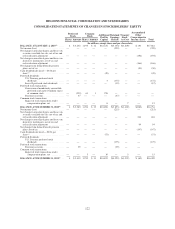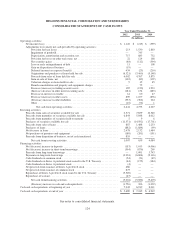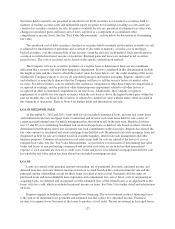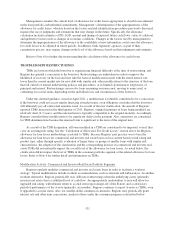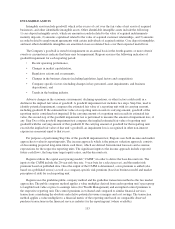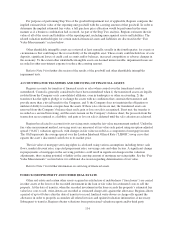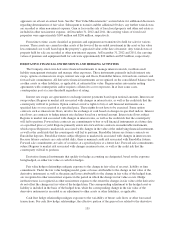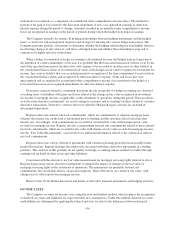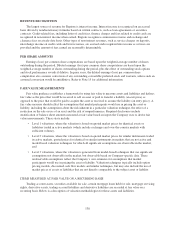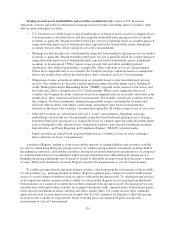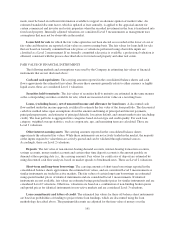Regions Bank 2012 Annual Report Download - page 147
Download and view the complete annual report
Please find page 147 of the 2012 Regions Bank annual report below. You can navigate through the pages in the report by either clicking on the pages listed below, or by using the keyword search tool below to find specific information within the annual report.
Management considers the current level of allowance for credit losses appropriate to absorb losses inherent
in the loan portfolio and unfunded commitments. Management’s determination of the appropriateness of the
allowance for credit losses, which is based on the factors and risk identification procedures previously discussed,
requires the use of judgments and estimations that may change in the future. Specifically, the allowance
calculation includes estimates of PD, LGD, amount and timing of expected future cash flows, value of collateral,
and qualitative factors such as changes in economic conditions. Changes in the factors used by management to
determine the appropriateness of the allowance or the availability of new information could cause the allowance
for credit losses to be adjusted in future periods. In addition, bank regulatory agencies, as part of their
examination process, may require changes in the level of the allowance based on their judgments and estimates.
Refer to Note 6 for further discussion regarding the calculation of the allowance for credit losses.
TROUBLED DEBT RESTRUCTURINGS
TDRs are loans in which the borrower is experiencing financial difficulty at the time of restructuring, and
Regions has granted a concession to the borrower. Restructurings are undertaken in order to improve the
likelihood of recovery on the loan and may take the form of modifications made with the stated interest rate
lower than the current market rate for new debt with similar risk, other modifications to the structure of the loan
that fall outside of normal underwriting policies and procedures, or in limited circumstances forgiveness of
principal and interest. Restructurings can involve loans remaining on nonaccrual, moving to nonaccrual, or
continuing on accrual status, depending on the individual facts and circumstances of the borrower.
Under the clarified guidance, issued in April 2011, a modification is refutably considered to be a concession
if the borrower could not access similar financing at market terms, even if Regions concludes that the borrower
will ultimately pay all contractual amounts owed. As a result of the new clarification, the amount of Regions’
reported TDRs increased in the third quarter of 2011. Regions’ original maturities of loans being modified are
relatively short (2-3 years), and the renewed term is typically comparable to the original maturity. Accordingly,
Regions considers these modifications to be significant delays in the payment. Also, extensions are considered
for TDR determinations because the renewed term is significant to the term of the original note.
As a result of the TDR designation, all loans modified in a TDR are considered to be impaired, even if they
carry an accruing risk rating. See the “Calculation of Allowance For Credit Losses” section above for Regions’
allowance for loan losses methodology as related to TDRs. Because Regions’ past practice was to base the
allowance for loan losses for commercial and investor real estate loans on loss content based on risk rating and
product type, either through specific evaluation of larger loans, or groups of smaller loans with similar risk
characteristics, the adoption of the clarification and the corresponding increase in commercial and investor real
estate TDRs did not materially impact the overall level of the allowance for loan losses. As noted below, the
clarification did not impact the level of TDRs in the consumer portfolio segment or the related allowance for loan
losses. Refer to Note 6 for further detail and information on TDRs.
Modification Activity: Commercial and Investor Real Estate Portfolio Segments
Regions regularly modifies commercial and investor real estate loans in order to facilitate a workout
strategy. Typical modifications include workout accommodations, such as renewals and forbearances. As another
workout alternative, Regions periodically uses A/B note restructurings when the underlying assets (primarily
investor real estate) have a stabilized level of cash flow. An appropriately underwritten A-note will allow for
upgraded risk rating, with ultimate return to accrual status upon charge-off of the B-note, and a satisfactory
period of performance of the A-note (generally, six months). Regions continues to report A-notes as TDRs, even
if upgraded to accrual status. Also, for smaller-dollar commercial customers, Regions may periodically grant
interest rate and other term concessions, similar to those under the consumer program as described below
131



